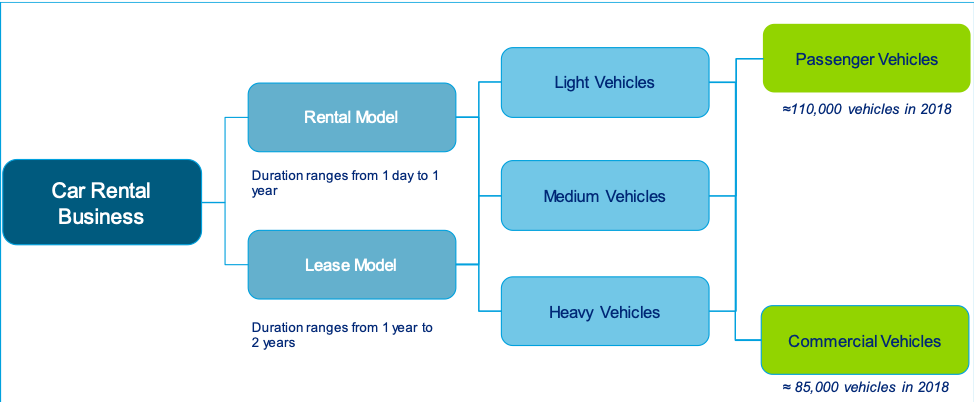Overview
An increase in expat population and growing trend of affordability among millennials can positively impact the car rental and lease business.
The UAE car rental and lease services market was estimated at USD 1.8 billion in 2018 and is expected to post a 7.0% CAGR to reach USD 2.5 billion by 2023—driven by inflow of international tourists, improvement in business environment and mega events such as Expo 2020.
Industry Structure
The industry can be broadly classified into the following:
The market can be segmented into rental and leasing services, which mainly differ in terms of tenure and ownership. While car rentals generally serve short-term purposes (<=1 year), leases are comparatively long (1–5 years). In a lease agreement, there is also a possibility of car ownership at the end, while rentals offer no such opportunities.
In 2018, car leasing was estimated to account for 55% of the total fleet (110,000) and 45% of the total market value (USD 1.8 billion). The market share of car leasing (by value) is lesser than that of car rentals, as leasing is cheaper than rentals.
Economy & midsized sedans and compact SUVs account for ~80% of the combined rental and lease fleet

Cars in the economy and low-end segment account for ~55% of the rental fleet. These types of cars are preferred by international tourists.
Short-term rentals are preferred by tourists. Most companies have an airport branch, as a majority of customers book car rentals from airport kiosks

Short-term rentals account for the remaining 30% of the rental fleet. Customers in this segment are mainly international tourists who usually rent cars for 1–2 weeks.
Highly concentrated industry, with the top 10 players accounting for ~68.3% of the total fleet

Small players are located in residential areas, accept cash payments (unlike their larger counterparts) and have negotiable prices, which are preferred by certain customer groups. Gross margin for the rental business varies between 25% and 32%, while that in the lease business is slightly lower at ~18–25%.
The market is expected to recover and grow at a healthy CAGR of 7.0%, driven by recovery in oil prices and higher tourist footfalls in events such as Expo 2020
The car rental and lease business grew at a healthy pace between 2013 and 2015, before decreasing between 2016 and 2018.
Slowdown in the market can be attributed to a decline in economic activity, which had a negative impact on the business environment and household income.
- Dubai is the primary market for car rental and leasing services in the county; however, Dubai is saturated, with many players offering services at competitive rates
- Abu Dhabi is focused on reducing its oil dependency. This is likely to diversify the business environment and attract more business travelers, boosting the car rental and lease market
- Over the years, tourist footfalls have also increased in the emirate. Today, Abu Dhabi hosts events such as the Grand Prix, which attracts a large number of tourists, thereby fuelling the demand for car rentals and leasing
Growth Drivers & Challenges
Growth drivers of rent-a-car market include the following:
- Increasing number of tourists
- Growing demand from the local market
- Lower cost of travel
- Declining oil prices and lower per capita income
- Growing preference for short-term rentals
- Rising trend towards electric car rentals
Challenges include the following:
- Operating challenges including maintenance & repair work (borne by fleet owners)
- Car renting is a seasonal business and largely depends on tourist footfalls and price fluctuations. Pricing and utilization of rental fleet increase during December–February, which is the peak tourist season
- Regulatory challenges
Conclusion
We believe that the UAE rent-a-car market remains highly competitive. Any decision pertaining to market entry needs to be taken based on further due diligence.


